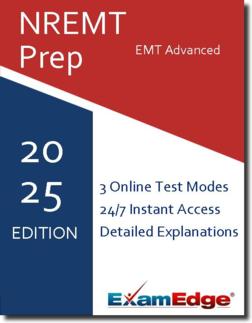NREMT EMT Advanced (EMT-Advanced) Practice Tests & Test Prep by Exam Edge - Topics
Based on 25 Reviews
- Real Exam Simulation: Timed questions and matching content build comfort for your NREMT EMT Advanced test day.
- Instant, 24/7 Access: Web-based NREMT National Registry of Emergency Medical Technicians EMT/ Advanced practice exams with no software needed.
- Clear Explanations: Step-by-step answers and explanations for your NREMT exam to strengthen understanding.
- Boosted Confidence: Reduces anxiety and improves test-taking skills to ace your NREMT National Registry of Emergency Medical Technicians EMT/ Advanced (EMT-Advanced).

Understanding the exact breakdown of the NREMT National Registry of Emergency Medical Technicians EMT/ Advanced test will help you know what to expect and how to most effectively prepare. The NREMT National Registry of Emergency Medical Technicians EMT/ Advanced has multiple-choice questions The exam will be broken down into the sections below:
| NREMT National Registry of Emergency Medical Technicians EMT/ Advanced Exam Blueprint | ||
|---|---|---|
| Domain Name | % | Number of Questions |
| Airway, Respiration & Ventilation | 17-21% | 19 |
| Cardiology & Resuscitation | 16-20% | 18 |
| Trauma | 19-23% | 21 |
| Medical/Obstetrics/Gyn | 26-30% | 29 |
| EMS Ops | 12-16% | 13 |


